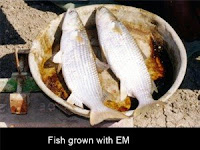EM is used in a variety of ways, mostly by mixing it with or applying it to other organic materials. The EM microbes can be activated by being fermented with (organic) molasses and quality (filtered) water.
Originally, EM was developed for use in agriculture (crop farming) as an alternative to agricultural chemicals. However, EM is not a fertilizer and unlike the purpose of fertilizers, the purpose of EM is to increase the number of beneficial microorganisms in the soil. This is to improve the soil's microbial health and promote a healthy environment for plants.
EM is mixed with organic matter to ferment it (usually the least expensive, most abundant and easily available material, such as rice bran or wheat bran, and other materials, including fish meal, bone meal, crab shells, etc. can be added to match nutrient requirements of the crop). This produces EM Bokashi ("bokashi" is a Japanese term meaning fermented organic matter). It is then applied to the soil as fertilizing material. (EM itself is not a fertilizer.)
From crop farming, its application flowed naturally into livestock. Outside the U.S., EM is actively used in livestock operations, including hog, cattle/dairy, and poultry.
From livestock, the positive effects on the livestock waste and effluent into lagoons and rivers led to the use of EM for environmental purposes: from land/soil remediation to water purification.
EM environmental applications throughout the world have included cleaning polluted waterways, lakes and lagoons, in septic systems, municipal wastewater treatment plants, landfills/dump sites.
More Introduction
Effective microorganisms (EM) technology has now become a major science, assisting in the creation of sustainable practices for agriculture, animal husbandry, nature farming, environmental stewardship, construction, human health and hygiene, industrial, community activities and more.
EM for Agriculture and Community Health.
The basic concept of EM in Agriculture is that multiple applications of beneficial and effective microorganisms improve the health of soils that produce healthy crops. EM is effective in organic farming as an alternative to chemicals. Its range of applications since 1982, has expanded into livestock and aquaculture as well as into Community Health areas such as waste treatment and other environmental applications. Today, EM has become very popular and is used in over 100 countries worldwide.
Composting
Apart from Agriculture, the most often recognised application of EM is composting your household waste.A "brew" of effective microorganisms can be added to your waste material in your composter which works on the waste and breaks it down. The beneficial role of this microbial solution has the ability to break down organic matter, thereby providing plant nutrients and enhancing physical and chemical properties.
Yogarty drinks with bacteria in them
The functional food market is growing at a rate of 15-20% per year, with rising consumer interest in health and continued strong growth in the soft drinks market.Yogurt-based, low acid, nutraceutical beverages targeted to adults and elderly person's needs have recently hit the market. They generally contain effective microorganisms as viable probiotic bacteria ABC type cultures and Maca (Lepidium Meyenii or Lepidium Peruvianum) as a supplement. Maca is a natural product very well known for its invigorating properties, promoting mental clarity, treating impotence, menstrual irregularities, and hormonal imbalance. The yogurt based drink formulation generally consist of yogurt, maca, glucose, stabilizer, natural and artificial flavors, and colorants.

